In the face of increased competition, Honda chose to arm the 2012 Gold Wing with only moderate improvements. This nonchalance begs the question: When will Honda retaliate with a full-model revamp? Until that event, whenever it may come, “it’s the little things that count” adage will have to suffice for Gold Wing devotees.
With Honda providing both 2012 and 2010 Gold Wing models for back-to-back comparison purposes, the minor upgrades gracing the 2012 GL were readily apparent. Trivial as the upgrades may be, they do exist, and the effort at least justifies the $300 increase in MSRP between 2010 and 2012 base models ($22,899 vs. $23,199, respectively).
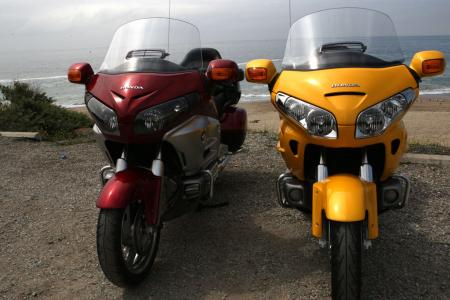 The 2012 Honda Gold Wing (left) sits next to the 2010 iteration, showing its new tires, revised side fairings and longer saddlebags. The 2012 Honda Gold Wing (left) sits next to the 2010 iteration, showing its new tires, revised side fairings and longer saddlebags. |
The purpose for this back-to-back comparo – made evident on the tight, switchback roads of California’s Coastal Range we were traversing – was to highlight the improved handling of the 2012 Gold Wing. Where the old Wing wore Dunlop tires, the new Wing is shod with Bridgestone rubber. But, as Honda was quick to point out, the Bridgestones were developed to work in harmony with the 2012’s revised suspension, so they won’t necessarily give new life to the old Wing.
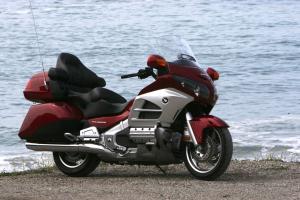 New silver side fairings are the most distinctive cue that you’re looking at the 2012 Gold Wing.
New silver side fairings are the most distinctive cue that you’re looking at the 2012 Gold Wing.Besides new top and bottom internal bushings in the fork, Honda was only able to say that there are revised front and rear suspension settings in the 2012 Wing. Front-wheel travel is stated at 4.8 inches, which is a reduction from the 5.5 claimed for the previous Wings. But Honda tells us that travel is actually unchanged, figuring the old spec was a typo and confirming the new 4.8-inch figure.
Whatever the case, there is a marginally improved aspect to the 2012 Gold Wing’s handling manners. I say marginally because the 2010’s handling is already impeccable for such weighty machine, but the new model is a little more eager to drop into a corner. And where the 2010 model requires slightly more input to hold its line navigating a long corner, the 2012 holds its lean angle and maintains the rider’s chosen arc. Cornering clearance seemed equal to the ’10 Wing, and both were equally resistant to bottoming out.
The most noticeable seat-of-the-pants improvement to the 2012 Wing, quite literally, is its seat. Hopping off the old model and onto the new model, it was clear that the new urethane seat material and seat cover are truly an improvement. Not quite Tempur-Pedic mattress material, but the GL’s new seat provided support equivalent to that level of comfort. And any passenger will be greeted by one of the best pillion seats in the business, a much more comforting place to sit than the BMW GTL’s seat – if you don’t want whining from the back seat, you’ll hear less of it with the Wing.
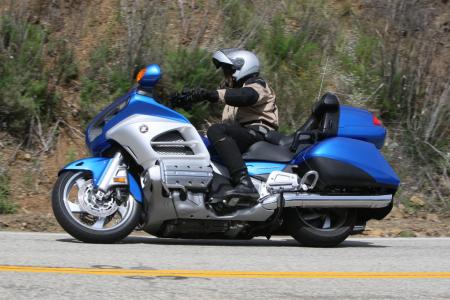 Through the decades, Gold Wings have always had great seats, and the one on the 2012 model could be its best yet. Through the decades, Gold Wings have always had great seats, and the one on the 2012 model could be its best yet. |
Because navigating a 900-pound motorcycle through territory where sportbikes normally roam demanded my full attention, I wasn’t able to fiddle with the Gold Wing’s upgraded electronics. Yes, I did manage to find an appropriate station on the Wing’s XM satellite radio (some heavy metal to accentuate the heavy peg grinding), but Honda did upgrade other aspects of its audio and navigation systems.
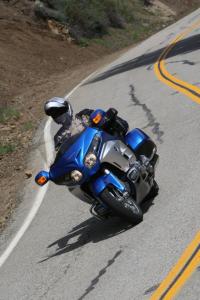 Honda engineers have made several suspension tweaks and fitted new tires to the 2012 Gold Wing. Turn-in response is slightly quicker than the venerable previous version, and cornering clearance remains excellent for such a big rig.
Honda engineers have made several suspension tweaks and fitted new tires to the 2012 Gold Wing. Turn-in response is slightly quicker than the venerable previous version, and cornering clearance remains excellent for such a big rig.New for the Wing’s audio system is MP3/iPod connectivity. Yes, the device connection resides in the top box, but its location is unimportant because Honda incorporated control of the iPod into its handlebar controls and dashboard view screen. You can access playlists, artists, albums, etc., just as if you had the device in your hand. There’s also a new surround-sound aspect to the speaker layout providing an enhanced listening experience. I could hear the rear speakers more clearly, even at freeway speeds.
Before leaving on our day ride, we were given a tech briefing on Honda’s new satellite-linked navigation system. According to Honda, the updated system provides more up-to-date information because of a quicker connection between bike and satellite. The viewing screen is also now brighter for better viewing.
A very usable new feature when traveling to unknown regions is the GPS’s lane-assist function that tells the rider in advance if the desired off-ramp is on the left or right of the freeway. There’s also a new 3-D terrain view. Next to the iPod connection in the top box is a new, removable flash card that allows Gold Wing owners to remove their route, download it to a personal computer then upload it and share it with fellow Gold Wingers.
Curiously, the new Gold Wing’s wheels come encased in a sheen of clear coating. Honda says it’s for easier cleaning and to keep the wheels in better shape for a longer period of time. For anyone who remembers the yellowy, peeling, clear-coated wheels from the 1980s, this may seem like a mistake. But Honda assured me that while the clear coat is the same recipe, the process of application has changed, and it was the process 30 years ago that caused motorcycle owners to spend hours with a fistful of steel wool stripping the baneful sealant from the wheels of their ride.
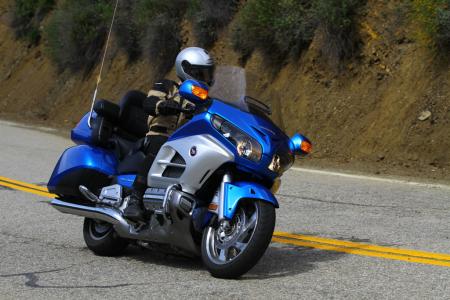 Upgrades to the 2012 Gold Wing include new iPod menu, surround sound, and a much more contemporary navigation system. Upgrades to the 2012 Gold Wing include new iPod menu, surround sound, and a much more contemporary navigation system. |
The redesigned fairing of the 2012 Gold Wing, with its color-contrasting side panels, is distinctive, setting the largely unchanged new Wing apart from its predecessors. The new look freshens the Gold Wing’s profile and, according to Honda, the fairing is slightly wider, providing improved wind protection.
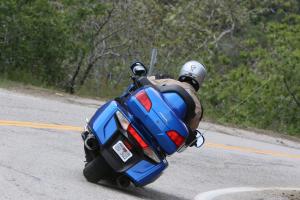 The Wing’s rear gets freshened up for 2012.
The Wing’s rear gets freshened up for 2012.While a better wind pocket was hard to confirm during the blustery afternoon spent aboard the two Wings, the restyled rear of the bike, with its relocated taillight, was visually pleasing and its functionality evident. By centralizing the taillight between the saddlebags and lengthening the saddlebags themselves, the new Gold Wing gains an additional seven liters of storage. Parked next to one another, the 2012 saddlebags appear smaller, but ‘tis only an optical illusion.
Another visual cue on the new GL is the engine cover directly above the brake/shift levers. It was chrome on the old model, but it’s now black to, according to Honda, “modernize” the look. But instead of being chrome or color-matched with an upgrade to one of the three trim levels above the base model, this unfinished, plastic, black panel comes on all 2012 Gold Wings. It looks cheaper in person than it does in pictures and is unbecoming for such a high-end motorcycle.
So the updated 2012 Gold Wing is a better a motorcycle, receiving upgrades in areas that truly benefit its rider. However, at $23,199 to $28,499, the Gold Wing is pricier than the new BMW K1600 GTL which retails for $23,200 to $25,845.
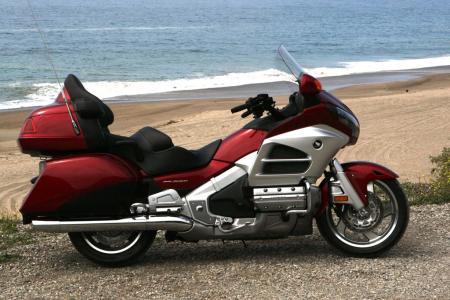 Our correspondent wasn’t a fan of the Wing’s new black engine cover. Our correspondent wasn’t a fan of the Wing’s new black engine cover. |
The new Beemer is faster, lighter, has Bluetooth connectivity and an electrically adjustable windscreen. But the Wing has more luxurious passenger accommodations and perhaps has a slight edge in slow-speed handling.
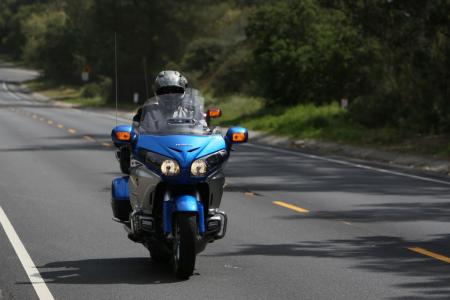 |
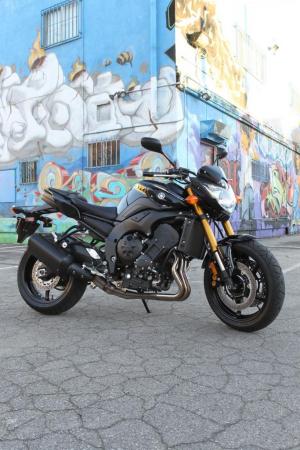 The FZ8 shares much in common with the FZ1.
The FZ8 shares much in common with the FZ1.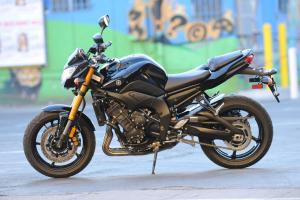 It already looks right at home.
It already looks right at home.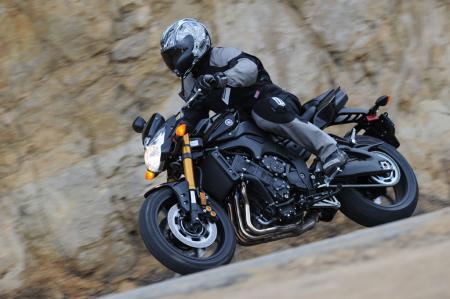
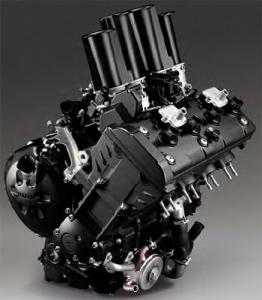
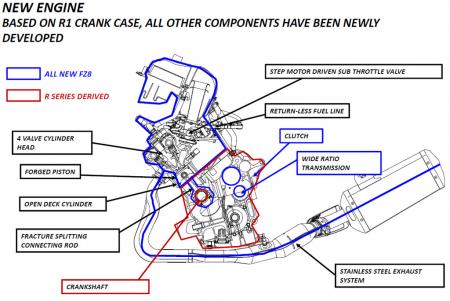
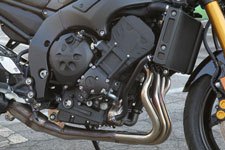
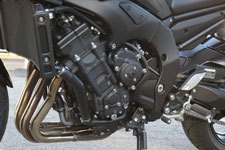
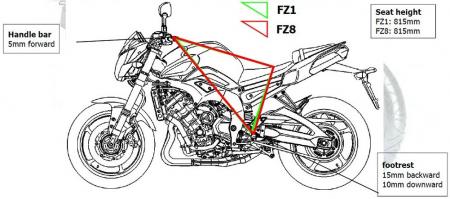
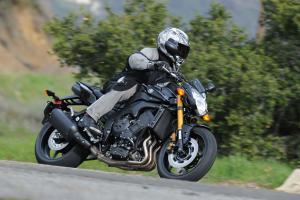 Comfortable, confidence-inspiring, and sufficiently powerful.
Comfortable, confidence-inspiring, and sufficiently powerful.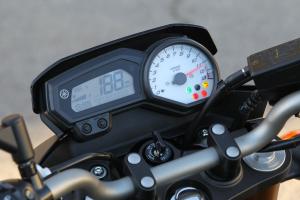
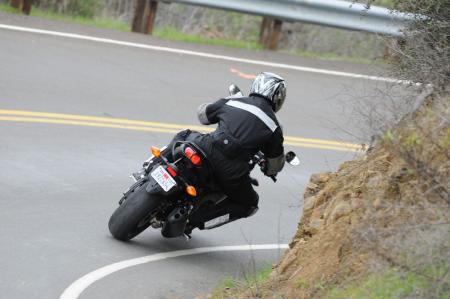 Thanks to Aerostich for its GORE-TEX® Roadcrafter one-piece suit – the perfect outfit for a cool and slightly rainy day.
Thanks to Aerostich for its GORE-TEX® Roadcrafter one-piece suit – the perfect outfit for a cool and slightly rainy day.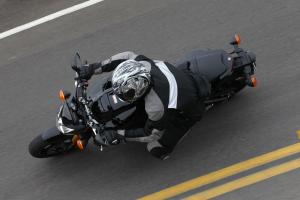 It’s easy to get used to this bike.
It’s easy to get used to this bike.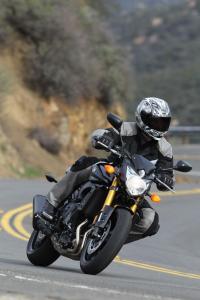 The extra torque over a 600-class bike is welcome.
The extra torque over a 600-class bike is welcome.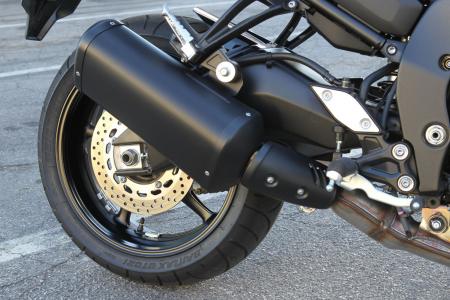 Of course it might sound cooler with an aftermarket exhaust, and make a few extra ponies. The stock system gives the stealth factor, however. You can scream it when you need to, without drawing unwanted attention. Note curvaceous, control-filled die-cast aluminum swingarm. The process lets Yamaha precisely tune its characteristics.
Of course it might sound cooler with an aftermarket exhaust, and make a few extra ponies. The stock system gives the stealth factor, however. You can scream it when you need to, without drawing unwanted attention. Note curvaceous, control-filled die-cast aluminum swingarm. The process lets Yamaha precisely tune its characteristics. 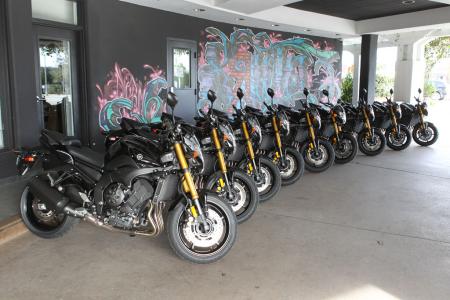 Yamaha had a fleet waiting for us at the lobby of a hotel in Venice, Calif.
Yamaha had a fleet waiting for us at the lobby of a hotel in Venice, Calif.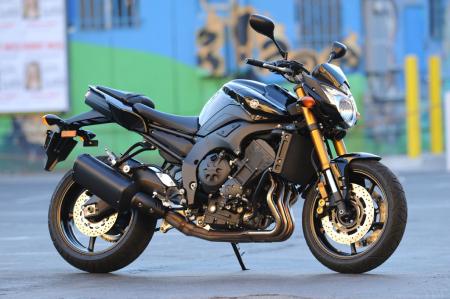 While there are bikes that arguably compete, in a real sense, the FZ8 stands alone.
While there are bikes that arguably compete, in a real sense, the FZ8 stands alone.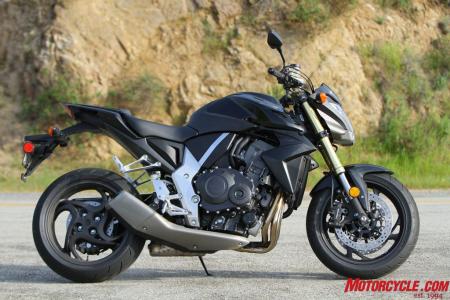 Every once in a blue moon we get a cool bike first seen in Europe on this side of the pond. In this case it’s the 2011 Honda CB1000R.
Every once in a blue moon we get a cool bike first seen in Europe on this side of the pond. In this case it’s the 2011 Honda CB1000R.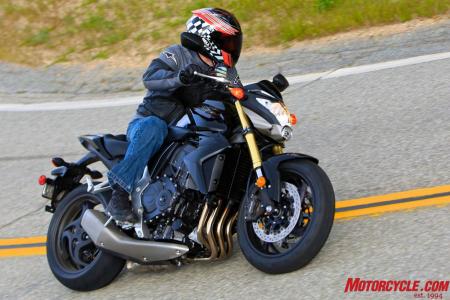 While it doesn’t make nearly as much power as the CBR1000RR it was sourced from, the “retuned” mill provides plenty of grunt for street riding.
While it doesn’t make nearly as much power as the CBR1000RR it was sourced from, the “retuned” mill provides plenty of grunt for street riding.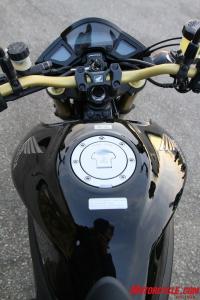 Pictures don’t do it justice, but when viewing the CB1000R in person from this angle, it really is svelte.
Pictures don’t do it justice, but when viewing the CB1000R in person from this angle, it really is svelte.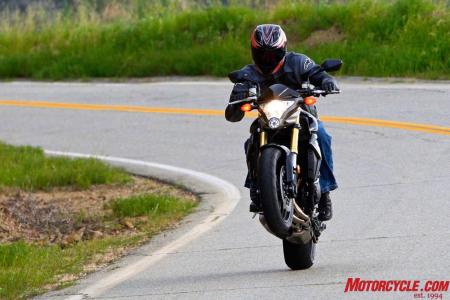 With plenty of torque on hand, simply sit back and twist the wrist and you’ll get results like this.
With plenty of torque on hand, simply sit back and twist the wrist and you’ll get results like this. 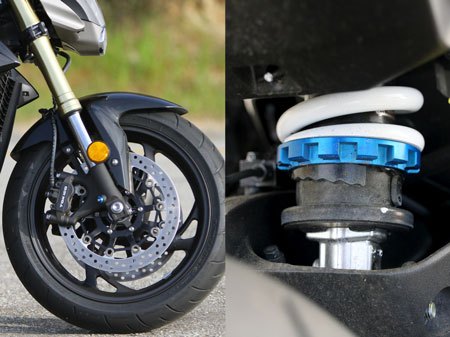 Suspension components are fully adjustable in front and lack only compression damping in the rear. Brakes on the CB are also competent for most situations, though our testers are split on their performance at the limit.
Suspension components are fully adjustable in front and lack only compression damping in the rear. Brakes on the CB are also competent for most situations, though our testers are split on their performance at the limit. 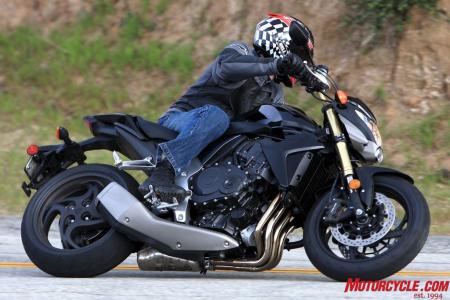 We’re impressed by the Honda’s supremely agile handling, which is at least partly due to the 180/55-17 rear tire. Note also the single-sided swingarm.
We’re impressed by the Honda’s supremely agile handling, which is at least partly due to the 180/55-17 rear tire. Note also the single-sided swingarm.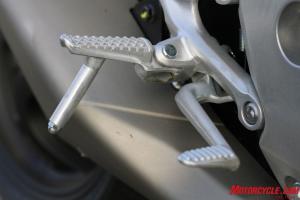 Get a little carried away with lean angle, and these comically long peg feelers will let you know.
Get a little carried away with lean angle, and these comically long peg feelers will let you know.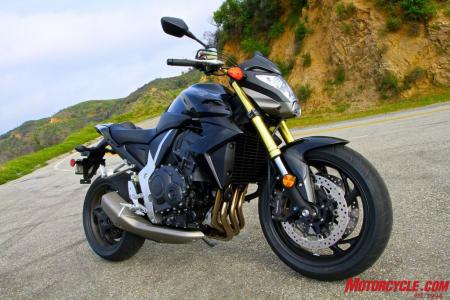
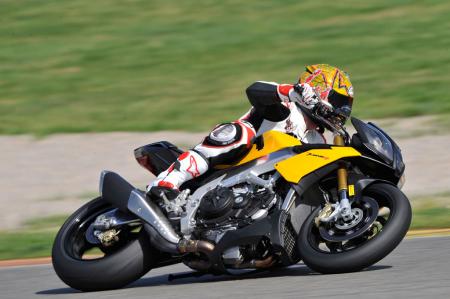 Our European correspondent enjoyed a day of riding the 2011 Aprilia Tuono V4R APRC on track and street with a dedicated mechanic...so this is how the other half lives.
Our European correspondent enjoyed a day of riding the 2011 Aprilia Tuono V4R APRC on track and street with a dedicated mechanic...so this is how the other half lives.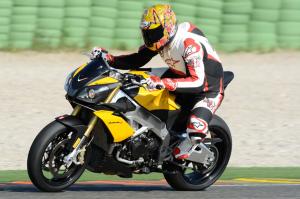
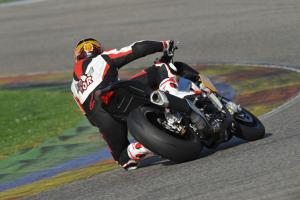 The Tuono V4R APRC leans into the corners like a superbike.
The Tuono V4R APRC leans into the corners like a superbike.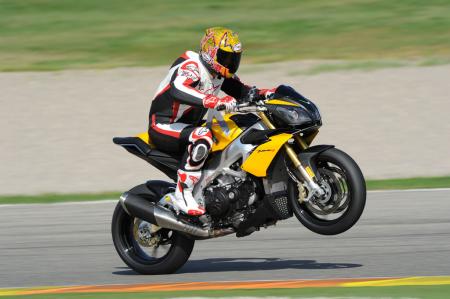 If you want to loft the front wheel skyward be sure to turn off the traction control.
If you want to loft the front wheel skyward be sure to turn off the traction control. Traction control is your friend when you’re cruising the motorways.
Traction control is your friend when you’re cruising the motorways.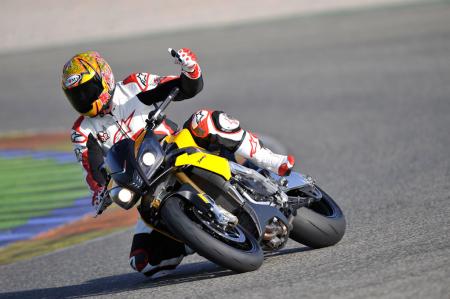
 Are you in need of enhancing the performance of your car by installing performance chips? Do you expect the performance chips to improve the performance of you Chevrolet?
Are you in need of enhancing the performance of your car by installing performance chips? Do you expect the performance chips to improve the performance of you Chevrolet? If you find the professionals charge a good deal of money to set up the car stereo, you can do it yourself and save that amount paid towards the expert.
If you find the professionals charge a good deal of money to set up the car stereo, you can do it yourself and save that amount paid towards the expert.